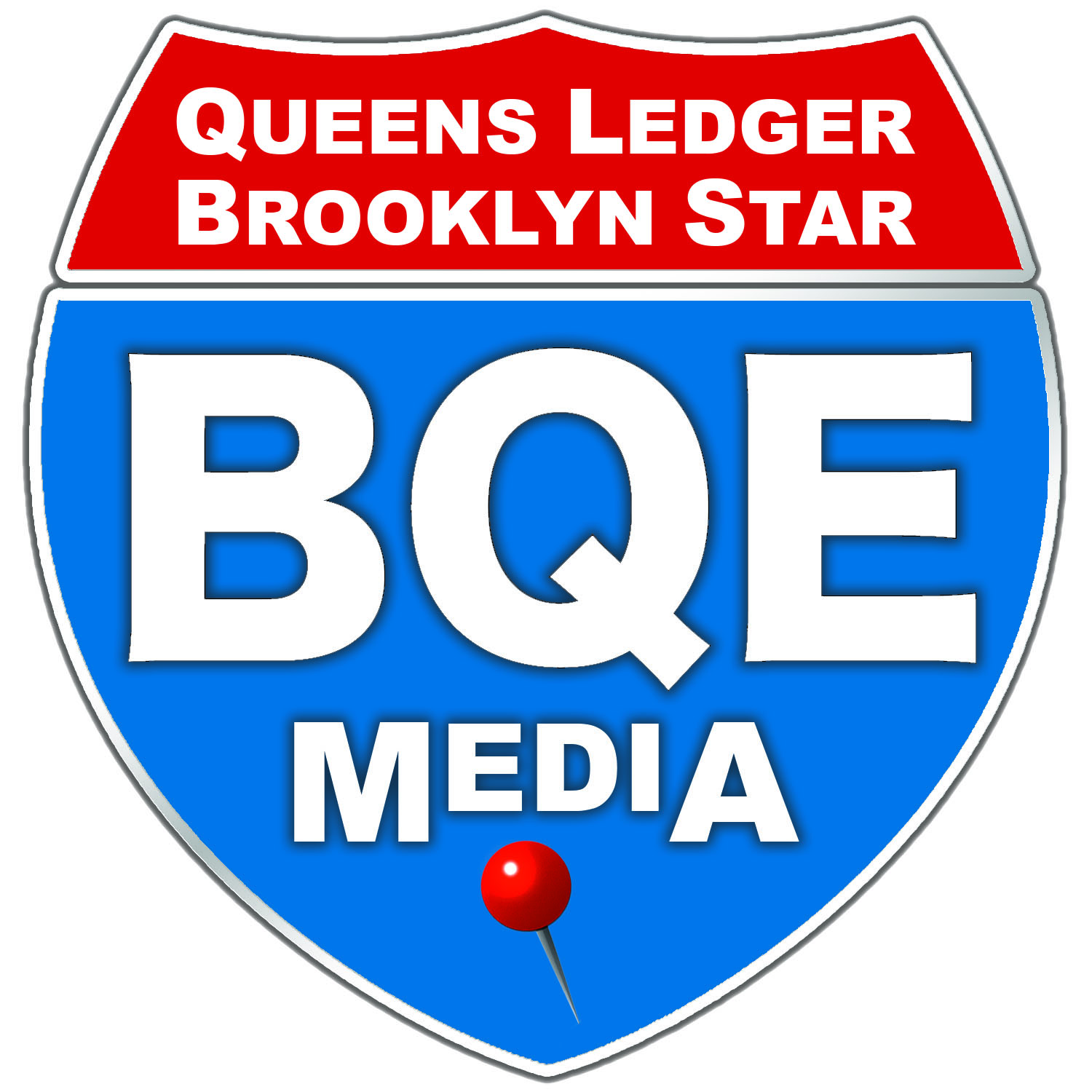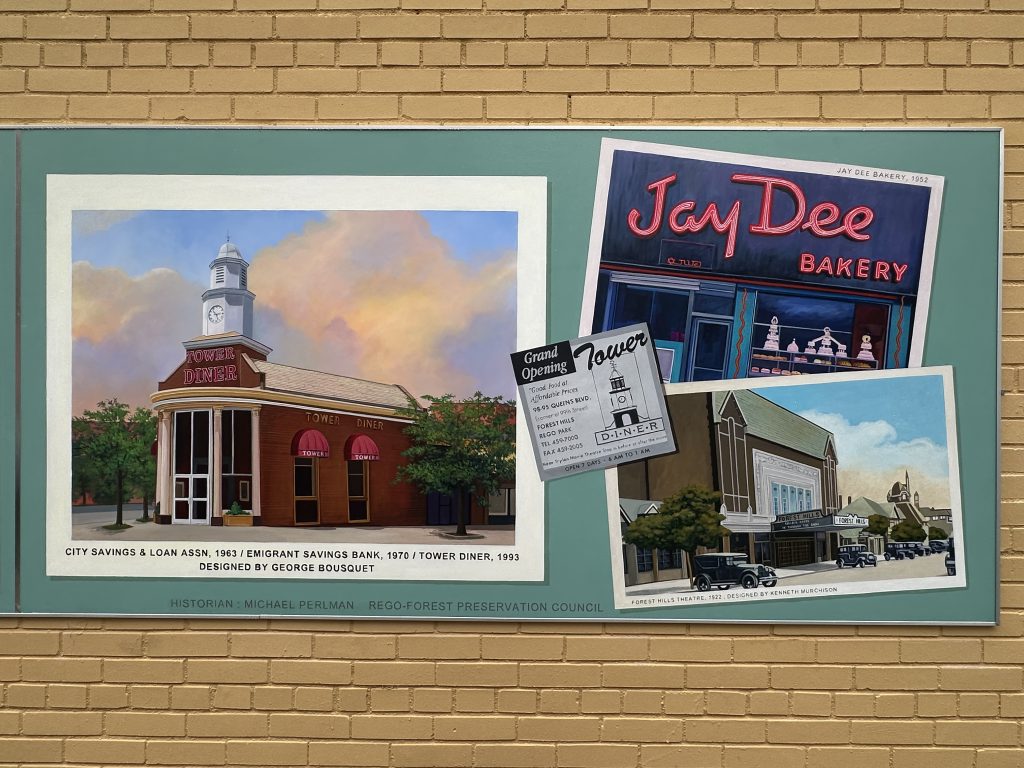By Michael Perlman
Last week’s column highlighted behind-the-scenes aspects and feedback on the new Forest Hills and Rego Park architectural mural, an exquisitely detailed 24-foot by 4-foot installation at The Bagel Spot at 101-01 Queens Boulevard, where the creative vision of several award-winning architects and old-word artisans is preserved. Since 2023, this columnist/Rego-Forest Preservation Council and Four Borough Neighborhood Preservation Alliance were in collaboration with the mural’s exceptional artist, Gigi Chen, appointed by this columnist as a project coordinator and historian. The highly skillful firm, Noble Signs, installed it on June 6.
Photo by Argenis Apolinario
In an ideal city, the featured historic buildings would be landmarked, but some underwent demolition. In the spirit of the Architectural Uprising movement, lost treasures can be replicated. Now it is time to explore architecture and history of what embodies “a living museum.”
Hollywood Lanes at the Metropolitan Industrial Bank Building ~ Opened on November 8, 1952 on 67th Avenue and Queens Boulevard in Forest Hills, and built at $400,000, the popular Hollywood Lanes housed 30 lanes, and offered lunch, dinner, a cocktail lounge, and a snack bar. General Manager Mannie Rose envisioned grand tournaments. The opening ceremony’s special guest was Dick Hoover of Akron, Ohio, who was the youngest bowler to win the All-Star tournament at age 21. Hollywood Lanes accommodated professional bowlers, championships, open bowling, and birthday parties. By 1990, New York City had 44 bowling alleys, in comparison to approximately 160 in the 1960s. It remained in operation until 2002, and is now occupied by New York Sports Club.
Architect Philip Birnbaum designed this bank, retail, and recreation building in partnership with builder Alfred Kaskel. The façade features concave polished stainless-steel horizontal fins. Swedish granite columns with vertical polished stainless-steel fins convey continuity throughout this Mid-Century Modern property, which won a first prize award by the Queens Chamber of Commerce in 1952.
Midway Theatre ~ This historic Art Moderne style theater stands proudly at 108-22 Queens Boulevard, with an accordion-like façade and vertical beacon, curved corner, and oval lobby with a sweeping stairway, and opened in 1942. It was designed by America’s foremost theater architect, Scotland native Thomas Lamb and consulting architect S. Charles Lee, and achieved a record as one of Queens’ longest continuously operating movie theaters.
Upon making an entrance, theatergoers once took pride in a large illuminated WWII Battle of Midway map-inspired work of art. When residents picked up The Forest Hills-Kew Gardens Post on September 18, 1942, they came across an ad stating, “The Midway Theatre has been so named and dedicated as a tribute to the gallant men of our armed forces, who achieved so brilliant a victory at Midway Island.” Patrons were ready for a single-screen theater, where they could enjoy films and attempt to escape WWII traumas.
Opening attractions were the U.S. Navy’s Technicolor short subject, “The Battle of Midway,” as well as “The Pied Piper” and “Just Off Broadway.” Other popular films were “Yankee Doodle Dandy,” “Casablanca,” “Pride of the Marines,” “Help!,” “West Side Story,” and “Saturday Night Fever.” Among the celebrities who made appearances were Bob Hope and Lucille Ball.The Midway screened first-run films, Walt Disney cartoons, and up-to-the-minute news, and operations shifted from RKO to Skouras to United Artists. It also transitioned from a single screen to a quad to nine screens.
Forest Hills Stadium with an eagle sculpture, and Frank Sinatra concert and Davis Cup tickets ~ The first tennis stadium countrywide was completed on August 11, 1923 in time for the Wightman Cup. The arched colonnade, graced with eagles and West Side Tennis Club crests, was designed by West Side Tennis Club member Kenneth Murchison, a foremost public buildings architect, and in partnership with engineer Charles Landers. It was erected by the Foundation Company of New York, whose expertise was superstructures and substructures internationally. In a 1922 edition of MIT’s “The Technology Review, an ad referenced it as “America’s Tennis Stadium.”
The nearby Tudor clubhouse features an extensive tennis player “wall of fame,” including portraits of Bill Tilden, Helen Jacobs, Rod Laver, John Newcombe, Andre Agassi, Billie Jean King, and John McEnroe. A series of firsts transpired on the stadium’s hallowed grounds. In 1953, Maureen Connolly Brinker was the first woman to win a Grand Slam. This was the U.S. Open’s birthplace. Singles and National Championships and the Davis Cup also made history. Since tennis was a segregated sport, racial color barriers were broken when Althea Gibson was the first African American to win a U.S. National Tennis title in 1957, and Arthur Ashe was the first African American man to achieve the U.S. Open title in 1968.
As of 1971, the stadium began hosting annual Robert F. Kennedy Pro-Celebrity Tennis Tournaments. The 1976 event, which benefited the Robert F. Kennedy Memorial, featured influential tennis players including Stan Smith, Jimmy Connors, Guillermo Vilas and Wimbledon crown recipient Björn Borg, who were joined by the Kennedy family, Chevy Chase, Walter Cronkite, Art Buchwald, and Muhammad Ali.
Frank Sinatra, Simon & Garfunkel, Bob Dylan, Barbra Streisand, Bette Midler, Trini Lopez, The Who, Hall & Oates, The New York Pops, and Santana are a miniscule percentage of musical legends since the stadium’s adaptation as a concert venue. The Forest Hills Music Festival originated in 1960, and the Stadium underwent a rebirth in 2013, where Mumford & Sons launched a new era. The stadium was also the setting of Alfred Hitchcock’s film, “Strangers on a Train” (1951), and The Beatles’ helicopter landing on grass courts before performing, which was among the most dramatic moments in 1964.
Howard Johnson’s ~ Rego Park residents were fortunate to have “The largest roadside restaurant in the U.S.” at 95-25 Queens Boulevard, which opened in 1940, a short distance away from the World’s Fair. The three-story, $300,000 restaurant occupied a Georgian Colonial mansion-like restaurant, designed by chief architect Joseph G. Morgan of the restaurant chain, and the building earned a 1st prize Queens Chamber of Commerce award. It was owned by Howard D. Johnson, who commissioned the Fair’s esteemed seafood chef, Pierre Franey. This is also where chef Jacques Pépin worked, and was later the recipient of an Emmy Award for Lifetime Achievement.
The façade featured sculptures, ornamental cast stone, pilasters, a portico, dormers, shutters, and urns, and was topped off with a cupola. An Art Deco roadside neon sign boasted 28 ice cream flavors, a grille, a cocktail lounge, steaks, chops, and chicken. The seating capacity was 700 indoors and 300 on its terraces. The Colonial Room and Empire Room dining spaces were available for weddings. Crystal chandeliers, murals designed by famed Parisian colorist Andre Durenceau (rescued by this columnist last year), and a winding grand stairway in the rotunda were regal appointments. By the early 1970s, industry standardization and a change in taste called for fast food, causing this American icon to undergo demolition in 1974. The Rego Park restaurant is depicted in author Paul Freedman’s book, “Ten Restaurants That Changed America.”
1939 World’s Fairgrounds featuring the Trylon & Perisphere monuments rising above Constitution Mall with the George Washington and Four Freedoms sculptures ~
“The World of Tomorrow” was a dominant theme of the 1939 – 1940 World’s Fair, which attracted millions of New York residents and tourists to Flushing Meadow for a celebration of technological innovations and cultural history like no other. It spanned the period of April 30, 1939 to October 27, 1940. Over 44 million visitors attended during the summers.
A linen postcard, designed for the Exposition Souvenir Corporation by the Grinnell Litho. Co. read, “On the theory that the best commemoration is a re-dedication, the New York World’s Fair 1939 celebrates the 150th anniversary of the inauguration of George Washington as the first President of the U.S. by dedicating itself to the task of building a ‘Better World of Tomorrow.’”
The Fair’s centerpiece was the symbolic Trylon and Perisphere monuments, which were a 700-foot spire and a 200-foot in diameter sphere, respectively, designed by Wallace K. Harrison and J. Andre Fouilhoux. In March 1937, Fair President Grover Whalen said, “Entering the sphere, the visitor will emerge on the moving platform. The effect will be that of suddenly stepping out into space. Far beneath he will see cities and towns and farmland, and all the interdependent activity that links them.”
Fairgoers would exit the Perisphere across a bridge to the ground by steps inside the obelisk or by an exterior 900-foot Helicline, a sweeping ramp around the fountain, which offered a commanding view. The Trylon’s monumentality was evident structurally and atop through a beacon of light. It was estimated to be the equivalent of five to ten million candlepower, which would be evident for 30 miles at sea and approximately 200 miles by plane.
Gulf Service Station ~ Rego Park once had its own version of the Empire State Building, as in a streamlined illuminated glass block Art Deco tower of the Gulf Station on the northeast corner of Queens Boulevard and Horace Harding Boulevard. A curved façade with curved windows and stainless steel accents were among the other novelty features, since nearby service stations exhibited Tudor and Mediterranean influences. It was erected by John Meehan & Son Construction Company for Gulf Oil Company. It was deemed futuristic, coinciding with the 1939 – 1940 World’s Fair’s “World of Tomorrow” theme, and was situated en route to the Fair when Horace Harding Boulevard was briefly known as World’s Fair Boulevard. The Gulf Station earned a 1st prize award by the Queens Chamber of Commerce in the commercial construction category. The site was redeveloped in 1987 when the 17-story Queens Boulevard Tower opened at 92-29 Queens Boulevard.
Trylon Theatre ~ With the advent of the 1939 – 1940 World’s Fair, Cooper Union alumnus Joseph Unger (1896 – 1996), designed an Art Deco neighborhood theater at 98-81 Queens Boulevard in Forest Hills to reflect the Fair’s technological innovations and respond to a booming population. It was named after the Fair’s symbolic monument, the Trylon, which was alongside the Perisphere. Analogous to the Fair’s theme, “The World of Tomorrow,” the theater was “The Theater of Tomorrow.” The marquee once boasted classics such as “The Wizard of Oz,” “Gone With The Wind,” and “The Ghost Breakers” starring Bob Hope.
Unique stone façade offered striated and fan-like details, an elliptical white tile marquee, and a sleek vertical glass block projection tower. The marquee and projection tower illuminated Queens Boulevard at night, much as the Trylon and Perisphere monuments made efficient use of light in Flushing Meadows. The projection tower was Joseph Unger’s rectangular variation of the globular Perisphere. The centerpiece of the entrance pavilion’s floor was terrazzo, bearing a 3D mirror image of the Trylon monument, complementary to the Trylon on the semicircular mosaic ticket booth. The floor was accompanied by a delightfully colorful array of inlaid mosaic tiles on both sides in a classic chevron pattern. The single-screen auditorium featured a stepped ceiling with curves among sleek accents, and the proscenium featured pilasters with thematic murals depicting media and sculpture in a growing city. The standee area featured a backlit Trylon mosaic fountain.
In 1999, the theater closed. In 2006, Ohr Natan, a synagogue and community center opened, but in 2022, the congregation was forced to relocate despite opposition due to condo plans.
Tower Diner bank building ~ Opened in 1993, Tower Diner at 98-95 Queens Boulevard in Forest Hills was a representation of a Greek-American dining classic. Owners Spiro and John Gatanas and their parents creatively adapted the Colonial Revival style Emigrant Savings Bank. Authentic features included an imposing clock tower/cupola with a weathervane and eagle, Corinthian columns, a slate pitched roof, a portico, and a cornice. Tower Diner was a must-stop for an extensive American and cultural menu, including chicken souvlaki, turkey burgers, spinach pies, cranberry chicken, and pasta primavera.
Earlier incarnations were a nightly dancing spot at Manna-Hatin Restaurant, which featured Billy Rose’s Aquabelles from the 1939 World’s Fair’s Aquacade, and Croft Chemists which housed a soda fountain. The corner Art Deco building was rebuilt for the City Savings & Loan Association circa 1963, and is believed to have been designed or inspired by Massachusetts native and award-winning architect George L. Bousquet, who once worked under Thomas Lamb, a foremost architect. Despite community resistance, Tower Diner was forced to shutter its location in late 2021, and was replaced by a condo.
Jay Dee Bakery ~ In Mid-Century Modern style pinkish red neon, massive Art Deco letters read “Jay Dee Bakery,” a neighborhood cornerstone at 98-92 Queens Boulevard from the early 1950s through 2009. Philip Kampin and Maurice Goldstein were noted as the owners in 1952. It recalled an era where rye bread, Napoleons, and assorted cookies were freshly prepared on premise, and the staff and patrons exchanged stories. Jay Dee catered numerous social functions. The window was a neighborhood showcase filled with multi-layer cake models. The façade’s whimsical Ravenna glass mosaics in green, orange, and gold were a work of art, and Moderne curves characterized the interior ceiling and walls, where indented clouds displayed cake models. In 2009, this columnist rescued the sign among other relics.
Forest Hills Theatre ~ The Tudor-style former theater at 107-16 Continental Avenue was designed by a foremost public buildings architect, Kenneth Murchison, and retains an ornate Tudor façade with lions, heraldic shields, fruits, knights, vines, urns, and tilework. For $300,000, the Sheer Amusement Company of Queens formally opened “the finest moving picture house on Long Island” on December 5, 1922, and it was the most complete of its kind and size countrywide. The façade would complement Forest Hills Gardens and was part of the adjacent section’s nickname, “The Village.” Its marquee boasted classics such as silent film “Through The Dark,” “Too Many Girls, “The Wizard of Oz,” “Alias Nick Beal,” “Planet of The Apes,” and “Dirty Dancing.”
The theater offered a resident orchestra and organist who played a rare four-manual Smith Unit Organ, sometimes embellished by singers and dancers for a silent film prelude. This also where the Garden Players of Forest Hills and Kew Gardens performed, and on Saturday mornings, children’s films endorsed by the Schools Motion Picture Committee were screened. The theater later featured mainstream and art films, and closed-circuit boxing broadcasts. In 1926, Helen Keller and Anne Sullivan lectured to benefit the American Foundation for the Blind’s mission. In 1971, Roger Williams, known for “Autumn Leaves,” played tunes, gave autographs, and introduced a computerized method of teaching piano and organ.



